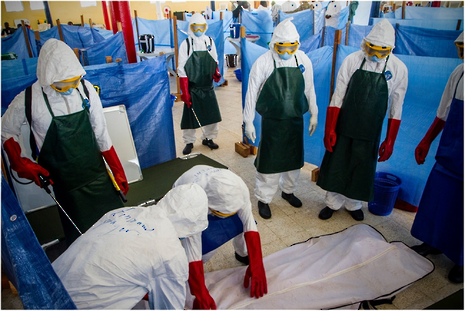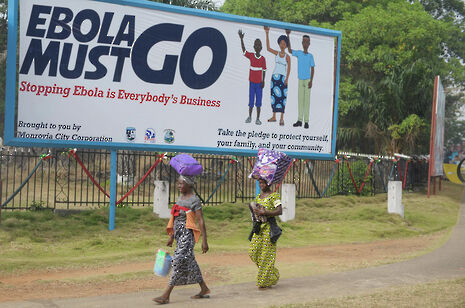The social life of Ebola
Jake Cornwall-Scoones suggests that to understand what went wrong with Ebola, we have to look past its horrific symptoms to its underlying social causes

This December will mark the three year anniversary of the first Ebola victim, a Guinean child who likely touched a dead bat infected with the virus and soon became uncontrollably sick. With the graphic images of haemorrhaging adults, piles of body bags and sterile treatment centres still on the minds of many, we must reflect on what went wrong initially, and how we can act to control better the epidemics of tomorrow. The Ebola epidemic illustrated the importance of social contexts in predicting disease dynamics. To understand how to deal with an epidemic, we must investigate the social lives of the disease.
Pathogens do not transmit in a vacuum. They propagate through a population whose dynamics will vary depending on their location, demography, and history, making an understanding of the socio-economic dynamics of the communities affected crucial. Previous outbreaks of Ebola were isolated and small, often occurring in villages, making them easy to contain. Strikingly, the virus causing these outbreaks was identical to the 2014 strain: when a pathogen meets a new social context, all bets are off as to how the epidemic will unfold.
The epidemic’s fate was sealed when the virus reached the cities of Guinea, Liberia, and Sierra Leone. Densely packed populations living in extreme poverty without proper access to sanitation provided the vital ingredients for rapid spread. The virus encountered new transmission methods facilitated by human inventions such as train and plane networks, allowing Ebola to spread fast.
Ebola is also a parasite of caregiving, that basic human requirement that we tend to the sick. Paul Richards, an anthropologist and author of Ebola: How a People’s Science Helped End an Epidemic, laments this “perverse sanction on those who are most assiduous in exercising their social duty”. This dynamic can be seen clearly when looking at the effect of gender and age on transmission routes. Although the numbers of cases for each sex is roughly the same, women tend to be infected more often at home and men more readily by the wider community. Additionally, adults usually care for older relatives and their children at home. Ebola hijacks these caregiving networks into transmission routes.
For a disease control effort to be effective, it is imperative that the population affected complies with new practices intended to limit disease spread. The social context of compliance is thus a pivotal factor in the spread dynamic. There is no use waiting for a vaccine, that even given less stringent ethical regulations and enormous funding would take years to produce; it is the people themselves that shape the spread. For Ebola, international agencies such as Médecins Sans Frontières among others worked with governments to implement these spread-reducing tactics including the Ebola Treatment Units (ETUs) caring for those infected, burial teams ensuring infected corpses were buried safely, and an extensive public health campaign. However, even if the necessary methods and resources are available, it is up to the population to use them.
“Stories of Ebola were unexceptional because disease is so prevalent in these countries”
The hostility of the ETUs, populated by the dehumanised, plastic-wrapped, and masked doctors, became associated with death. Their friends and family members entered these sterile make-shift hospitals, never to return. This, coupled with a more general lack of trust in the authorities, who have systematically failed to meet the basic requirements of locals, deprived citizens of economic betterment, and driven their own people to civil-war, resulted in widespread non-compliance with public health interventions. For example in Monrovia, the capital of Liberia, a quarantine of suspected individuals was raided due to the rumours of cannibalism at the centres, causing many people harbouring Ebola viral particles to re-enter the population.

Locals were not listening to the authorities out of ignorance but rather acted on what they saw and knew. Stories of Ebola were unexceptional because disease is so prevalent in these countries that any amount of media scaremongering won’t feel real. This effect is only worsened by the “amnesia of public health”, to quote Sharon Abramowitz: a lack of trust in the systems of public health, meaning people are less likely to act upon symptoms. With foreign doctors working in a death house and a corrupt government providing health advice, no wonder people were sceptical.
In West Africa, traditional burials come with certain rituals, “bath[ing] in … rinse water from the washing of corpses” or “sleep[ing] near a highly infectious corpse”, according to the WHO. Ebola is a highly infectious disease, infecting those in contact with body fluids carrying the pathogen, leading to 80% of total infections being attributed to these ceremonies in Sierra Leone. The safe burial measures imposed included the disposal of corpses in black bags and their burial without a proper ceremony, going against traditional rituals, further coaxing non-compliance.
The blame for the failure of these interventions lay not in the hands of West Africans, rather the implementers themselves, producing “top-down, standardised responses and control measures, provok[ing] local fears or feelings of injustice”, as Melissa Leach, director of the Institute of Development Studies, puts it. Understanding the social context of a disease is critical, yet these dynamics were poorly analysed by policymakers, and any existing knowledge was ignored regardless.
“We need to look at those suffering and dying not in projection, but in reality”
Pollach & Pietruck
It is also important to review the response to the Ebola epidemic in the context of its surrounding halo of media hype. The doomsday picture painted by newspapers, predicting worldwide contagion, proved to be an excellent story, but not one rooted in reality. Western countries got scared, funnelling money into containment efforts, including the World Bank spending more on the Ebola crisis than the entire health budget of Malawi, not out of altruism but instead, seemingly, a selfish fear that Ebola would spread to them. Many deemed this investment unethical, including Malawian doctors Pollach & Pietruck, who demanded in a letter in The Lancet that the international community look at those “suffering and dying not in projection, but in reality”, contextualising Ebola with other leading causes of death including malaria and road traffic accidents.
There are many lessons to be learned from the crisis of 2014. For future major epidemics, understanding how humans interact, both within organisations and on the ground, will significantly help curb spread, bringing to the fore the importance of social science. Co-creation of knowledge is key: if community members, medics and policy-makers generate strategies together, local people will comply with them. This time, changes in behaviour, partially due to community-based education implemented at the peak of the crisis, resulted in the containment of Ebola. Next time, when the pathogen is more infectious, more easily transmissible, and more deadly, we may not be so lucky
 News / Students launch women’s society excluding trans women31 October 2025
News / Students launch women’s society excluding trans women31 October 2025 News / Climate protesters rally against the Careers Service5 November 2025
News / Climate protesters rally against the Careers Service5 November 2025 News / New Christ’s library approved4 November 2025
News / New Christ’s library approved4 November 2025 Theatre / Hitler at the ADC? These guys pull it off5 November 2025
Theatre / Hitler at the ADC? These guys pull it off5 November 2025 News / Sidney May Ball cancelled6 November 2025
News / Sidney May Ball cancelled6 November 2025








